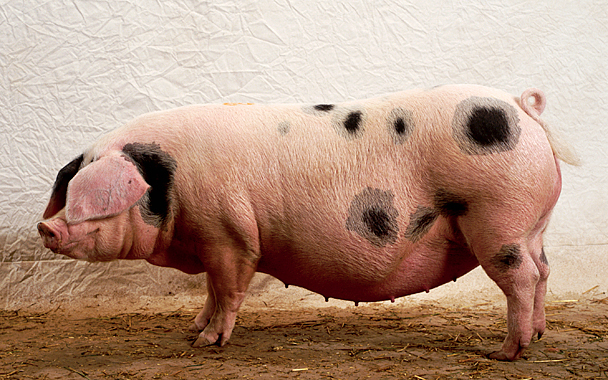Pork used to be so simple. Ten years ago, a trip to the butcher shop to buy some pork left you with only the options of cut. A chop tonight? Maybe a ham hock for beans or a nice chunk of shoulder for pulled pork? These days, the farmers market and the meat counter have become jam-packed with odd names: Ossabaw, Tamworth, and Berkshire, to name a few. The pork we sell at Marlow & Daughters is all from heritage-breed pigs, but while most chefs agree that these animals taste better, no one seems to be able to say why they do or even why some breeds are more popular than others. I thought I should ask a couple of farmers.
“Choose a pig you can live with,” says Michael Grady Robertson, the director of agriculture at the 47-acre Queens County Farm Museum, which runs a stand at the Union Square Greenmarket in Manhattan. He has been raising pigs for only a few years, but his favorite is already clear. “I prefer the Gloucester Old Spot,” he says, “because of temperament, appearance, and taste. We’ve raised Tamworth-Large Black crosses, Tamworth-Gloucester Old Spot crosses, and a few Hampshire-Tamworth crosses, but, temperamentally, the GOS pigs are much more docile and easy to handle.” Robertson goes on to tell me about a particular Gloucester Old Spot that had a bad leg. “It was really accepting of my massaging arnica gel on that sore leg,” he says fondly.
Michael Yezzi of Flying Pigs Farm in Shushan, New York (which produces the pork we sell at Marlow and Daughters), agrees. “My favorite is the Gloucester Old Spot,” he says. “They’re called an orchard pig, bred to have a mild disposition so that they will eat all the fruit that drops in an orchard but not destroy the trees.” Yezzi relates a story get rid of a particularly aggressive Ossabaw boar that chased him around the barnyard one day.
So why is it, I wondered, that most of the heritage pork we see around isn’t from the lovable and peace-loving Gloucester Old Spot? Robertson explains: “So far, the GOS pigs have taken a month or two longer to reach slaughter weight than the other breeds. The difference is notable even at a few weeks. I kept wondering whether the GOSs would catch up, but they never did. If I were in it for the money, I might go for a Tamworth instead. Feeding for two extra months is a solid chunk of change.”
Again, Yezzi concurs. “Rare heritage breeds do grow more slowly than […] Durocs, Yorkshires, and Berkshires,” which are among the more popular heritage-breed pigs. “Tamworths, though, were bred to be bacon pigs, meatier than lard pigs; they grow a little faster than the others.”
While the financial and flavor considerations are important, the argument for certain breeds—like the Gloucester Old Spot—goes even deeper. After Yezzi bought the land for Flying Pigs Farm in the late 1990s to secure the parcel from encroaching developers, he and his partner, Jennifer Small, realized their mission wasn’t over. “We were attracted to the rare heritage breeds because there are so few of them and they need help to keep from becoming extinct,” he says. “Large Blacks, GOSs, and Ossabaw pigs are listed by the American Livestock Breeds Conservancy as ‘critical,’ which means there are fewer than 200 registrations in the U.S. and an estimated global population of less than 2,000.” Farmers like Yezzi and Small are helping to increase the animals’ numbers.
Still, at the end of the day, the choices that most farmers make come down to the pigs’ potential worth on the table. Yezzi, despite his run-ins with the combative breed, speaks rapturously about his Ossabaw pigs: “They’re a feral breed that is often used for charcuterie because of their marbling and the quality of their fat.” Robertson says of his Old Spots: “I’ve found that the slower-growing pigs have much more fat on them and retain more moisture when they’re cooked.” Perhaps Yezzi sums it up for all heritage-breed farmers when he says, “Pasture-raised, rare, heritage-breed pigs just taste the best.”



 Pinterest
Pinterest


